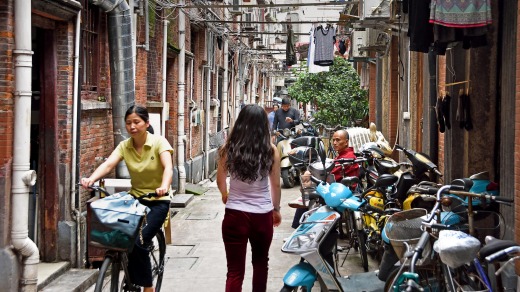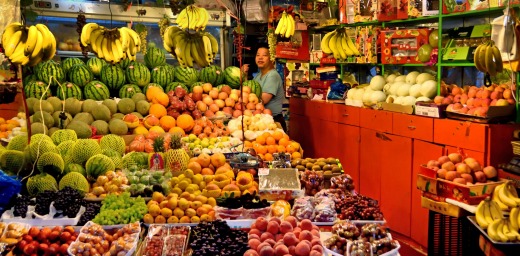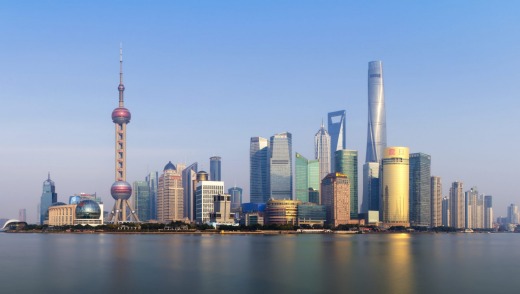
Shanghai is one of the world's most thrilling cities, but it's even more thrilling when you're being driven around it in the sidecar of a 1950s-era Chang Jiang motorcycle.
I've never been in a sidecar before and the prospect of roaring around this crazy metropolis in a seat that's lower than the traffic is daunting. Being a passenger in a Shanghai taxi is hair-raising enough, let alone in a Cold War-era contraption that has no roof and takes you into the heart of the city's traffic, where rules are generally not obeyed. At sidecar level, the dents and scratches on just about every other car are frighteningly apparent.
We meet Max Tondeur from Shanghai Insiders outside the Andaz hotel in the fashionable Xintiandi neighbourhood. My husband and I have opted to take a sidecar each, which means two handsome bikes are waiting for us, one gleaming black, the other military green.

Belgian-born Max, who is our guide and will drive one of the bikes, says they're probably 'the most politically incorrect bike in the world, owned by Hitler, stolen by Stalin and copied by Mao.' The German-designed technology (the prototype was the 1938 BMW R71) was handed over to the Chinese by the Soviets in 1957 for military use, but in later decades they were popular in rural areas. You'd see farmers driving their chickens around in the sidecar, Max says.
The 750CC bikes we will ride are compounds of old and new, carefully maintained. Max explains we'll be going no faster than 30 miles an hour and that the drivers generally take side streets, not major arteries where the traffic is at its most kamikaze. As it turns out, I feel entirely secure as we roar along; my only concern is that my long scarf doesn't give me an unfortunate Isadora Duncan moment in the wheels.
Before we even head off on our two-hour tour, Max consults us about the route, using an old 1930s map of the city. The tours are entirely tailor-made to passengers' interests, whether it's photography, markets, architecture, old and new Shanghai and more. Max cautions against using the sidecars to take us to touristy places, such as the Yu Gardens. 'Use me and my sidecar to take you to places you'd never go to and find on your own,' he says. 'I'm like the friend of a friend you wish you had to show you around.'

One of the most popular routes is driving through the picturesque old French Concession, along streets that are lined with graceful plane trees. But I've been to Shanghai five times and know the Concession well. I ask: can you show me somewhere I've never been? Max suggests Hongkou, on the north side of the Garden Bridge, rarely visited by tourists, a neighbourhood that still has original lane houses and remnants of 19th and 20th century Shanghai life.
Max, who has lived in Shanghai for three years, turns out to be a history buff, with a great eye for what's curious and quirky about the city. Because he wants to show us a rare old painting of Mao he's found on a laneway wall across town, we have to negotiate some freeways to get there.
Heading off through the morning traffic, over knots of raised concrete roads, it's exhilarating fun. I've chosen not to wear a crash helmet because I want to feel the breeze in my hair. (I've checked my travel insurance.) It's not a particularly polluted day, luckily. You smell everything but you absorb so much more at this level. Wherever we go, there are men in their 60s or later who give us friendly waves because they have memories of driving the bikes during military service.

We drive through an archway into an old lane and a typical neighbourhood. Max says it's slated for demolition soon. The residents will be moved somewhere where there's running water and better sanitation, probably a high-rise on the rapidly growing Pudong side of the river. I think this is a pity, because community life in the lanes seems wonderful - but, of course, it's not fun living somewhere that's picturesque for Westerners when your sanitary conditions are pretty grim.
The painting of Mao is surprisingly intact, given that it is in an alleyway, hidden behind washing on a line. Max explains that the symbolic depiction of a young Mao in blue robes ('Chairman Mao goes to Anyuan') is a hand-painted copy of the most important painting of the Cultural Revolution period. We feel privileged to see it, especially knowing it may not be there next time we visit Shanghai. 'It's not the Chinese mindset to renovate,' Max explains. 'They just let it get old and then they pull it down.'
We are in a part of the city that was once swampland, so the roads snake along the creek and waterways. Our next stop is the old neighbourhood around the vast Baoshan electronics market, with covered stalls selling refurbished, smuggled, fake and knockoffs of big electronic brands like Apple and Samsung, components, old FM radios. It even has a section devoted to drones.
Max takes us through some narrow alleys until we arrive at the main 'street' (not more than a lane) in a labyrinth of traditional 'shikumen' houses. These were built from the 1840s throughout Shanghai. The city was made prosperous in the 19th Century by foreigners dealing in opium and other goods such as tea, and they invested heavily in real estate, building rental properties based on the workers cottages in the UK. As many families as possible were ultimately crammed inside. The buildings were built solidly of brick, unlike the wooden Chinese houses, which is why they have lasted into the 21st century - and would last longer if the wrecker's ball wasn't coming for them.
The main streets of these developments run north-south, with branching side lanes, always east-west. There's the occasional little shop and alcove where men play cards. The streets are strung with washing, children and small dogs run about, and clusters of bicycles lie against the walls. There is a lot of humanity here, but it's ordered and clean.
Each house has communal areas, such as kitchen and courtyard. Visiting the lane houses has always been one of my favourite things to do in Shanghai and it's perfectly fine to walk into most houses and have a look, even take photographs. Max explains this is because the hallways, courtyards and kitchens don't belong to anyone, but everyone.
Interestingly, given the housing affordability crisis in Australia, many of these houses are owned by the residents, who were given the opportunity to buy a stake when Shanghai real estate was in the doldrums. If the land is purchased for development they are likely to become instant CNY millionaires. No wonder they look so happy.
Our last stop is 1933, one of the world's most remarkable art deco buildings, and yet one I've not known about until now. Vegetarians may want to skip it, as the massive four-storey concrete structure of Escher-like interlocking ramps and air bridges was built as an abattoir between 1930-1933 and that's what it still feels like, despite an extensive restoration in 2008 to turn it into a creative industries hub.
The feng shui must be pretty bad because the place is mostly deserted, except for a Russian restaurant, a hairdressing academy and a couple of boutiques and model agencies. But that's good news for anyone who wants to take photographs. There's in fact a fashion shoot taking place under the sky-lit circular roof, which was once open for ventilation. The cattle were delivered at the bottom and sent up corrugated ramps to the top floor butchers' shops, where the animals were processed. Slides sent the processed meat to the next level before finally reaching the ground floor again for shipping out.
You can't escape the gruesome nature of it, but the British-designed building is astonishingly beautiful in a brutal way with fantastic vistas from its staircases and views of Shanghai from the top level, when it is open. As grim as it is, it's popular for weddings.
We end our tour by going back to Xintiandi via the French Concession to experience, at least for a few minutes, the bliss of speeding along under the canopy of plane trees on a warm day.
Shanghai Insiders offers one hour, two hour and four hour sidecar tours. One hour is a fun transfer, two hours gives you two or three stops in depth and four hours is suggested if you've never visited Shanghai before.